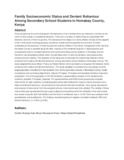| dc.contributor.author | Aute, Dorothy Anyango | |
| dc.contributor.author | Poipoi, Moses Wesang’ula | |
| dc.contributor.author | Khasakhala, Okaya Edward | |
| dc.date.accessioned | 2021-12-15T14:02:11Z | |
| dc.date.available | 2021-12-15T14:02:11Z | |
| dc.date.issued | 2020-02-25 | |
| dc.identifier.uri | https://doi.org/10.11648/j.sjedu.20200801.13 | |
| dc.identifier.uri | sciencepublishinggroup.com/journal/paperinfo?journalid=197&doi=10.11648/j.sjedu.20200801.13 | |
| dc.identifier.uri | http://ir-library.mmust.ac.ke:8080/xmlui/handle/123456789/1866 | |
| dc.description.abstract | Every society has its norms that govern the behaviour of its members thus any behaviour contrary to the norms of the society is considered deviance. There are a number of factors that are associated with deviance and one of them is poverty. The socioeconomic status of a family affects virtually all the aspects of life in that family including physical, emotional, mental and the parental environment. It further contributes to the behaviour of both the parents and the children in the family. Irrespective of the fact that Homabay County is situated along the lake, majority of the residents languish in abject poverty and consequently there is rampant deviance among the secondary school students in Homabay County. Deviance has devastating effects which include destruction of learning facilities, early pregnancies, arrests and even deaths. The objective of the study was to evaluate the relationship between family socioeconomic status and deviant behaviour among secondary school students inHomabay County. The study adopted Structural Strain Theory by Robert Merton which provided a conceptual link between family socioeconomic status and deviant behaviour. The study adopted a correlational survey design and the target population included form two students from all the secondary schools in Homabay County, heads of guidance and counseling department, Deputy Principals, Principals and selected members of parents association. Out of the population of 20,160 students a representative sample of 512 students was randomly sampled. Principals, Deputies, PA representatives and HODs were purposively sampled. Instruments for data collection included questionnaires administered to measure family socioeconomic status and deviant behaviour, structured and unstructured interview schedules, focus group discussions and analysis of documents from the sampled schools. Instruments were then piloted. The validity of these instruments was ascertained through expert judgment and piloting while the reliability of the instruments was tested using the Split half method and the level of confidence was α ≤ 0.05. Data was analyzed both quantitatively and qualitatively. The findings revealed significant negative correlation between SES and deviant behaviour (r=-0.644, p<0.05) | en_US |
| dc.language.iso | en | en_US |
| dc.publisher | Science Journal of Education | en_US |
| dc.subject | Family, Socioeconomic, Status, Deviant, Behaviour, Secondary, School, Students | en_US |
| dc.title | Family Socioeconomic Status and Deviant Behaviour Among Secondary School Students in Homabay County, Kenya | en_US |
| dc.type | Article | en_US |

